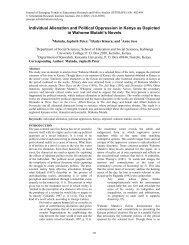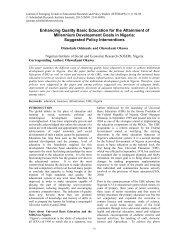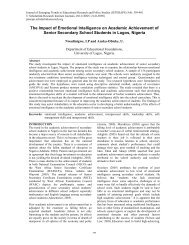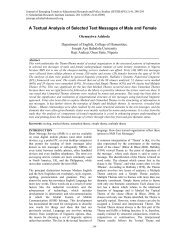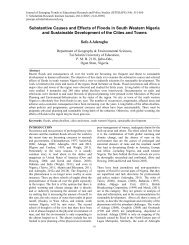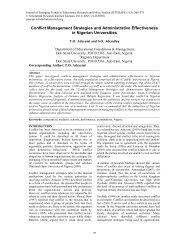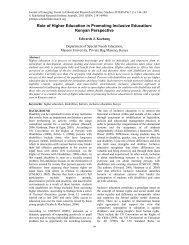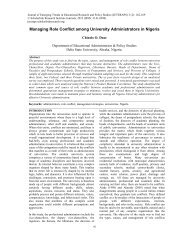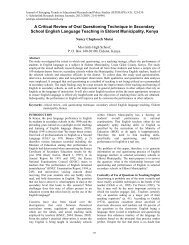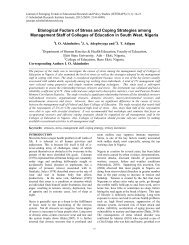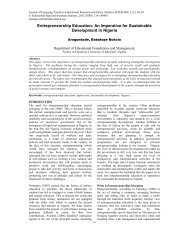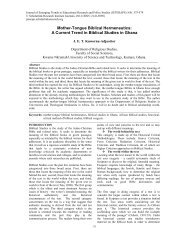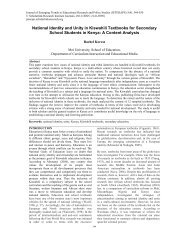Weather Forecasting and Indigenous Knowledge Systems in ...
Weather Forecasting and Indigenous Knowledge Systems in ...
Weather Forecasting and Indigenous Knowledge Systems in ...
Create successful ePaper yourself
Turn your PDF publications into a flip-book with our unique Google optimized e-Paper software.
Journal of Emerg<strong>in</strong>g Trends <strong>in</strong> Educational Research <strong>and</strong> Policy Studies (JETERAPS) 3(4): 561-566<br />
Journal © Scholarl<strong>in</strong>k of Emerg<strong>in</strong>g Research Trends Institute <strong>in</strong> Educational Journals, 2012 Research (ISSN: <strong>and</strong> 2141-6990) Policy Studies (JETERAPS) 3(4):561-566 (ISSN:2141-6990)<br />
jeteraps.scholarl<strong>in</strong>kresearch.org<br />
<strong>Weather</strong> <strong>Forecast<strong>in</strong>g</strong> <strong>and</strong> <strong>Indigenous</strong> <strong>Knowledge</strong> <strong>Systems</strong> <strong>in</strong><br />
Chimanimani District of Manical<strong>and</strong>, Zimbabwe<br />
Joshua Risiro, Dom<strong>in</strong>ic Mashoko, Doreen, T. Tshuma, <strong>and</strong> Elias Rur<strong>in</strong>da<br />
Department of Curriculum Studies,<br />
Great Zimbabwe University,<br />
Masv<strong>in</strong>go, Zimbabwe.<br />
___________________________________________________________________________<br />
Abstract<br />
The study focused on how traditional knowledge is used to forecast weather <strong>in</strong> the Chimanimani District <strong>in</strong><br />
Manical<strong>and</strong> Prov<strong>in</strong>ce of Zimbabwe. It is the purpose of this study to show how <strong>Indigenous</strong> <strong>Knowledge</strong> <strong>Systems</strong><br />
[IKS] have been used by rural communities to predict weather <strong>and</strong> seasonal changes <strong>in</strong> their environment. A<br />
descriptive survey was adopted us<strong>in</strong>g open ended questionnaires <strong>and</strong> <strong>in</strong>terviews to collect <strong>in</strong>formation <strong>in</strong> order<br />
to assess peoples’ underst<strong>and</strong><strong>in</strong>g, attitudes <strong>and</strong> beliefs on the value of <strong>in</strong>digenous knowledge on weather<br />
prediction. Purposive sampl<strong>in</strong>g was applied to collect data from people purported to be rich <strong>in</strong> <strong>in</strong>digenous<br />
knowledge. It was found that biological, atmospheric conditions, astronomic <strong>and</strong> relief features are used to<br />
predict weather over short <strong>and</strong> long periods of time. Temperature <strong>and</strong> w<strong>in</strong>d patterns were regarded as po<strong>in</strong>ters to<br />
weather changes. The behaviour of animals <strong>and</strong> <strong>in</strong>sects were less mentioned as useful <strong>in</strong> determ<strong>in</strong><strong>in</strong>g weather<br />
conditions. Human ailments such as operations were po<strong>in</strong>ted out as accurate <strong>in</strong>dicators of impend<strong>in</strong>g weather<br />
changes. Astronomic features were used to predict weather especially com<strong>in</strong>g of ra<strong>in</strong>s with<strong>in</strong> a period of about<br />
two weeks. The study notes that there is rapid disappearance of plants <strong>and</strong> animals due to climate variability <strong>and</strong><br />
human activities. There are few elders aware of traditional methods of weather forecast<strong>in</strong>g. This makes<br />
traditional weather forecast less reliable. The study concludes that both modern <strong>and</strong> traditional methods have got<br />
some positives <strong>and</strong> weaknesses <strong>and</strong> therefore can be used together to produce more comprehensive reports of<br />
weather forecasts for end users. The <strong>in</strong>formation on IKS is useful for end users <strong>in</strong>clud<strong>in</strong>g farmers, planners,<br />
educators, weather forecasters <strong>and</strong> Non Governmental Organisations [NGO’s].Traditional leaders need to be<br />
empowered to assist <strong>in</strong> the conservation of resources <strong>in</strong> their communities. Traditional methods of weather<br />
forecast<strong>in</strong>g should be part <strong>and</strong> parcel of the school curriculum at all levels of education.<br />
__________________________________________________________________________________________<br />
Keywords: <strong>in</strong>digenous knowledge systems; weather forecast<strong>in</strong>g; climate variability; traditional leaders;<br />
conservation; climate change; ra<strong>in</strong> mak<strong>in</strong>g ceremonies.<br />
__________________________________________________________________________________________<br />
INTRODUCTION<br />
<strong>Indigenous</strong> <strong>Knowledge</strong> <strong>Systems</strong> (IKS) is a body of<br />
knowledge or bodies of knowledge of the <strong>in</strong>digenous<br />
people of a particular geographical area that have<br />
survived on for a very long period of time [Mapara,<br />
2009:140]. <strong>Indigenous</strong> knowledge determ<strong>in</strong>es<br />
decision mak<strong>in</strong>g <strong>in</strong> areas such as agriculture <strong>and</strong><br />
resource management [Warren, 1991].<br />
<strong>Indigenous</strong>/Traditional methods of weather<br />
predictions have been used s<strong>in</strong>ce time immemorial<br />
but with the com<strong>in</strong>g of modern methods of weather<br />
forecast<strong>in</strong>g these traditional methods have tended to<br />
be ignored. Mhita [2006] noted that before modern<br />
methods of weather forecast<strong>in</strong>g the rural communities<br />
of Tanzania observed plants, animals <strong>and</strong> birds for<br />
weather forecast<strong>in</strong>g. In Burk<strong>in</strong>a Faso apart from<br />
observ<strong>in</strong>g the behaviour of animals <strong>and</strong> plants<br />
cultural <strong>and</strong> ritual specialists use visions, dreams <strong>and</strong><br />
div<strong>in</strong>ation to predict weather [Rocoli et al, 2001 cited<br />
<strong>in</strong> IPCC Fourth Assessment Report, 2007]. There is<br />
therefore a need to promote these methods tak<strong>in</strong>g<br />
cognizance of climate change which makes modern<br />
methods less reliable especially <strong>in</strong> rural areas where<br />
there is <strong>in</strong>adequate weather forecast<strong>in</strong>g <strong>in</strong>struments.<br />
There is need for research <strong>in</strong> traditional methods to<br />
compliment modern weather forecast<strong>in</strong>g so as to<br />
produce more reliable <strong>and</strong> valid <strong>in</strong>formation for end<br />
users. In addition those people with valuable<br />
<strong>in</strong>formation (elders) are pass<strong>in</strong>g away <strong>and</strong> liv<strong>in</strong>g<br />
organisms such as plants <strong>and</strong> animals are quickly<br />
disappear<strong>in</strong>g or ext<strong>in</strong>ct due to climate change <strong>and</strong><br />
overpopulation. Grace [2008] observed that global<br />
warm<strong>in</strong>g <strong>and</strong> recurrent droughts has resulted <strong>in</strong><br />
ext<strong>in</strong>ction of both plants <strong>and</strong> animals. It has also<br />
resulted <strong>in</strong> the replacement of orig<strong>in</strong>al plants by<br />
drought resistant ones <strong>and</strong> changes <strong>in</strong> the flower<strong>in</strong>g<br />
of plants <strong>and</strong> shedd<strong>in</strong>g of leaves. Chang’a et al<br />
[2010:67] po<strong>in</strong>ted out that, weather <strong>and</strong> climate<br />
prediction is under threat due to lack of<br />
documentation <strong>and</strong> death of old people who have got<br />
the knowledge. The <strong>in</strong>formation on traditional<br />
methods is not be<strong>in</strong>g fully harnessed to help the<br />
greater population <strong>in</strong> Zimbabwe hence the need to<br />
tape this knowledge. Southern Africa <strong>in</strong>clud<strong>in</strong>g<br />
Zimbabwe is very vulnerable to the negative effects<br />
of climate change such as changes <strong>in</strong> seasons. Most<br />
561
Journal of Emerg<strong>in</strong>g Trends <strong>in</strong> Educational Research <strong>and</strong> Policy Studies (JETERAPS) 3(4):561-566 (ISSN:2141-6990)<br />
communal areas <strong>in</strong> Zimbabwe rely much on natural<br />
ra<strong>in</strong>s such that accuracy <strong>in</strong> weather prediction results<br />
would improve farmers yield <strong>and</strong> productivity. The<br />
community would also be able to plan for natural<br />
hazards such as frost, drought <strong>and</strong> floods. In the<br />
Philipp<strong>in</strong>es Farmers <strong>and</strong> Fishermen rely on observ<strong>in</strong>g<br />
the behaviour of animals <strong>and</strong> <strong>in</strong>sects to predict the<br />
com<strong>in</strong>g of ra<strong>in</strong>s <strong>and</strong> bad weather [Galasgac <strong>and</strong><br />
Balisacan, 2003]. <strong>Indigenous</strong> <strong>Knowledge</strong> of weather<br />
forecast<strong>in</strong>g can be comb<strong>in</strong>ed with the modern<br />
methods to produce more reliable <strong>and</strong> accurate<br />
forecasts. In Western Kenya Ra<strong>in</strong>makers from the<br />
Nganyi family has got sacred shr<strong>in</strong>es with <strong>in</strong>digenous<br />
trees they use to predict weather. Their weather<br />
forecast <strong>in</strong> comb<strong>in</strong>ed with that from the Kenyan<br />
Meteorological Department to produce more accurate<br />
weather reports [Thomson Reuters Foundation,<br />
2012]. Rural communities <strong>in</strong> many parts of Tanzania<br />
use <strong>Indigenous</strong> knowledge to cope up with hazards<br />
related to climatic variability [Changa, Y<strong>and</strong>a <strong>and</strong><br />
Ngana, 2010]. In Australia the Government make use<br />
of <strong>Indigenous</strong> knowledge <strong>in</strong> order to cater for the<br />
varied microclimates <strong>in</strong> the region [Australian<br />
Government Bureau of Meteorology, 2010]. Recent<br />
<strong>in</strong>formation on weather forecasts <strong>in</strong> Southern Africa<br />
has shown a difference between what is needed by<br />
farmers <strong>and</strong> what is provided by modern<br />
meteorological services [Blench, 1999]. These<br />
suggest a grow<strong>in</strong>g need to complement modern<br />
methods of forecast<strong>in</strong>g with traditional ones.<br />
Modern Methods of <strong>Weather</strong> <strong>Forecast<strong>in</strong>g</strong><br />
<strong>Weather</strong> forecast<strong>in</strong>g is a scientific estimate of the<br />
weather conditions at some future time which are<br />
expressed <strong>in</strong> terms of variables such as temperature,<br />
precipitation <strong>and</strong> w<strong>in</strong>d [Lutgens <strong>and</strong> Tarbuck, 2010].<br />
It is a statement of weather expected to occur <strong>in</strong> a<br />
particular area dur<strong>in</strong>g a stated time period [Buckle,<br />
1996:218].<strong>Weather</strong> forecast<strong>in</strong>g can either be<br />
subjective or numerical. Subjective forecast<strong>in</strong>g is<br />
based on describ<strong>in</strong>g the current daily observation of<br />
the atmosphere <strong>and</strong> what has been happen<strong>in</strong>g <strong>in</strong> the<br />
past. The observations are then <strong>in</strong>ferred to the future<br />
[Buckle, 1996]. The method is cheap, simple <strong>and</strong><br />
therefore can be easily used <strong>in</strong> poor countries where<br />
f<strong>in</strong>ances <strong>and</strong> technology are poor. Numerical<br />
forecast<strong>in</strong>g is an objective method that uses<br />
mathematical equations <strong>and</strong> physical laws to simulate<br />
atmospheric conditions <strong>and</strong> then predict weather<br />
conditions. The technique use high technology such<br />
as satellites <strong>and</strong> radar (radio detection <strong>and</strong> rang<strong>in</strong>g)<br />
[Buckle, 1996].In Zimbabwe this is done by the<br />
Meteorological Services Department <strong>in</strong> Belvedere,<br />
Harare. It is expensive s<strong>in</strong>ce it requires high<br />
technology <strong>and</strong> expertise. It is therefore a challenge<br />
to Least Develop<strong>in</strong>g Countries such as Zimbabwe.<br />
Modern weather forecast<strong>in</strong>g can be done over short<br />
or long period. Very short range forecast can cover<br />
up to 12 hours <strong>and</strong> can be used to predict the<br />
movement of cyclones. Short range forecast caters for<br />
periods from 12 hours up to few days [Lutgens <strong>and</strong><br />
Tarbuck, 2010:353].Medium range forecasts ranges<br />
from few days up to two weeks. <strong>Weather</strong> predictions<br />
<strong>in</strong> excess of one month are grouped under long term<br />
forecasts [Barry <strong>and</strong> Chorley, 1968].This type of<br />
weather forecast is more general as it predicts<br />
averages <strong>and</strong> variability of weather elements over<br />
long periods. The accuracy of such predictions are<br />
still poor [Lutgen <strong>and</strong> Tarbuck, 2010].<br />
Problems <strong>in</strong> Modern <strong>Weather</strong> <strong>Forecast<strong>in</strong>g</strong><br />
In Least Economically Developed Countries<br />
(LDC’s), modern weather forecast<strong>in</strong>g is a problem<br />
due to shortage of weather data. There are few<br />
weather stations at the ground <strong>and</strong> upper air stations.<br />
This is worsened by poor<br />
telecommunications[Buckle,1996].In addition there is<br />
<strong>in</strong>sufficient underst<strong>and</strong><strong>in</strong>g of atmospheric processes<br />
such as pressure <strong>and</strong> w<strong>in</strong>d that are important to<br />
predict weather. Aguado <strong>and</strong> Burt [2010] noted that<br />
modern weather forecast may be imperfect due to<br />
factors such as lack of <strong>in</strong>formation about the<br />
composition of the atmosphere, unstable atmospheric<br />
composition <strong>and</strong> air motions <strong>in</strong> the atmosphere. The<br />
cost to acquire weather forecast equipment is a great<br />
h<strong>in</strong>drance <strong>in</strong> poor countries <strong>in</strong> their quest to produce<br />
reliable <strong>and</strong> accurate forecasts [Buckle, 1996].<br />
Modern weather forecasts make use of Global<br />
Climate Models (GCM) which are developed from<br />
global air circulations. These models are based on the<br />
patterns of greenhouses gases <strong>in</strong> the atmosphere.<br />
These greenhouse gases are dependent on the global<br />
social, political <strong>and</strong> economic development. These<br />
parameters are difficult to predict mak<strong>in</strong>g weather<br />
forecast<strong>in</strong>g models less reliable [Grace, 2008].<br />
This paper focused on <strong>Indigenous</strong> knowledge<br />
<strong>Systems</strong> used by the community of Chimanimani<br />
District, Zimbabwe to predict weather us<strong>in</strong>g<br />
biological, atmospheric conditions, astronomic<br />
features <strong>and</strong> traditional ceremonies. It is the argument<br />
of this paper that the current modern methods of<br />
weather forecast<strong>in</strong>g is a positive development but for<br />
Least Economically Developed Countries burdened<br />
by numerous problems rang<strong>in</strong>g from <strong>in</strong>adequate<br />
weather stations, f<strong>in</strong>ancial problems <strong>and</strong> rapid<br />
degradation of the environment there is need to fuse<br />
both modern <strong>and</strong> traditional methods <strong>in</strong> order to<br />
produce more accurate weather forecast for the local<br />
communities. The problem <strong>in</strong> which vegetation <strong>and</strong><br />
animals are fast disappear<strong>in</strong>g due to human activities<br />
<strong>and</strong> the effects of climatic change makes it m<strong>and</strong>atory<br />
to fuse modern <strong>and</strong> traditional weather forecasts to<br />
improve on weather predictions. A record of methods<br />
used to forecast weather <strong>in</strong> local communities is<br />
important s<strong>in</strong>ce it addresses the needs for a particular<br />
community. Modern methods tend to generalise the<br />
f<strong>in</strong>d<strong>in</strong>gs more particularly with the scarcity of<br />
forecast<strong>in</strong>g equipment <strong>in</strong> develop<strong>in</strong>g countries.<br />
562
Journal of Emerg<strong>in</strong>g Trends <strong>in</strong> Educational Research <strong>and</strong> Policy Studies (JETERAPS) 3(4):561-566 (ISSN:2141-6990)<br />
IMPORTANCE OF THE STUDY<br />
The study is of value to scholars <strong>and</strong> readers as it<br />
stimulate them to undertake further research <strong>in</strong><br />
weather issues. The research has illum<strong>in</strong>ated<br />
researchers <strong>in</strong> traditional methods of weather<br />
forecast<strong>in</strong>g <strong>and</strong> how they fit <strong>in</strong>to current<br />
developments <strong>in</strong> climate variability. Readers shall be<br />
acqua<strong>in</strong>ted with <strong>in</strong>digenous knowledge systems<br />
utilized with<strong>in</strong> a given region. The f<strong>in</strong>d<strong>in</strong>gs can be<br />
used or compared with other research done <strong>in</strong> other<br />
regions. Modern scientific weather researchers can<br />
f<strong>in</strong>d ways of blend<strong>in</strong>g their f<strong>in</strong>d<strong>in</strong>gs with IKS <strong>in</strong><br />
order to produce more reliable forecasts. Similarities<br />
<strong>and</strong> variability <strong>in</strong> the perceptions on weather<br />
predictions are revealed through this research. A wide<br />
range of end users such as farmers <strong>and</strong> planners can<br />
plan for the effects of climate variability such as<br />
extreme heat <strong>and</strong> cold spells.<br />
of participants was <strong>in</strong>tended to access peoples’<br />
underst<strong>and</strong><strong>in</strong>g, attitudes, views <strong>and</strong> beliefs on<br />
traditional methods of weather forecast<strong>in</strong>g. A time<br />
frame of one week was given <strong>in</strong> which the researcher<br />
would collect the questionnaires. Ten elders (10) <strong>in</strong><br />
the community were purposively sampled for<br />
<strong>in</strong>terviews. These were selected on the basis that they<br />
were old <strong>and</strong> assumed to be rich on <strong>in</strong>formation<br />
regard<strong>in</strong>g traditional methods of weather forecast<strong>in</strong>g.<br />
These elders have the knowhow of what was done <strong>in</strong><br />
the past on predict<strong>in</strong>g weather that determ<strong>in</strong>ed their<br />
activities particularly preparation of l<strong>and</strong>, plant<strong>in</strong>g<br />
<strong>and</strong> harvest<strong>in</strong>g.<br />
Biological <strong>Weather</strong> <strong>Forecast<strong>in</strong>g</strong> Indicators<br />
Table 1: Biological weather forecast<strong>in</strong>g Indicators<br />
Predictors Description <strong>Weather</strong> forecast<br />
Interpretation<br />
THE STUDY AREA<br />
Chimanimani District is situated to the East of<br />
Zimbabwe. The council offices for the district are<br />
150 kilometres from the Prov<strong>in</strong>cial capital, Mutare.It<br />
shares its boundary with Mozambique <strong>in</strong> the East<br />
with Chimanimani mounta<strong>in</strong> ranges form<strong>in</strong>g the<br />
boundary. The Save river mark the western boundary.<br />
It shares the southern boundary with Chip<strong>in</strong>ge<br />
District <strong>and</strong> northern boundary with Mutare rural.<br />
River cover<strong>in</strong>g places like Nyanyadzi <strong>and</strong> Gudyanga.<br />
As a result of varied relief the district is classified<br />
<strong>in</strong>to five regions with region one which is wetter <strong>and</strong><br />
cool to the East <strong>and</strong> semi arid region to the west. The<br />
varied relief <strong>and</strong> climate produces variations <strong>in</strong><br />
vegetation <strong>and</strong> soils as we move from the highl<strong>and</strong>s<br />
<strong>in</strong> the East to the lowl<strong>and</strong>s <strong>in</strong> the west. The highl<strong>and</strong>s<br />
are characterised by trees such as musasa<br />
[Brachystegia spiciformis], mutondo [Julbernardia<br />
globiflora], mupfuti [Brachystegia boehmii] <strong>and</strong><br />
muunze [Brachystegia glaucescens].Towards the<br />
western lowl<strong>and</strong>s dry resistant trees <strong>in</strong>clud<strong>in</strong>g acacia,<br />
Mopani <strong>and</strong> baobab are dom<strong>in</strong>ant. There is a wide<br />
range of animal species <strong>in</strong> the Chimanimani Park <strong>and</strong><br />
domesticated animals by the rural communities. The<br />
population is largely Ndau tribe <strong>and</strong> practice ma<strong>in</strong>ly<br />
Christianity <strong>and</strong> African traditional religion. Chiefs<br />
namely Ngorima <strong>and</strong> Chikukwa, Muusha <strong>and</strong><br />
Mutambara play a major role <strong>in</strong> the conservation of<br />
resources <strong>and</strong> tradition.<br />
METHOD OF STUDY<br />
The study was carried out <strong>in</strong> Chimanimani District <strong>in</strong><br />
Manical<strong>and</strong> Prov<strong>in</strong>ce, Zimbabwe. A descriptive<br />
survey was used. Purposive sampl<strong>in</strong>g was used <strong>in</strong><br />
adm<strong>in</strong>ister<strong>in</strong>g questionnaires <strong>and</strong> <strong>in</strong>terviews. Fifty<br />
three (53) adult participants spread over all villages<br />
were issued with questionnaires. The participants<br />
were chosen from people with vary<strong>in</strong>g educational<br />
<strong>and</strong> social backgrounds. Adults were chosen as they<br />
were believed to be <strong>in</strong>formed on <strong>Indigenous</strong><br />
knowledge of weather forecast<strong>in</strong>g. A broad stratum<br />
563<br />
Plants bloom<strong>in</strong>g of plants onset of summer season<br />
plants shedd<strong>in</strong>g off leaves dry season<br />
abundance of fruits eg Drought<br />
mazhanje[Uapaca kirkiana]<br />
<strong>and</strong> hacha[Par<strong>in</strong>ari<br />
curatellifolia]<br />
Animal Presence of millipedes, frogs, Onset of ra<strong>in</strong> season<br />
behaviour<br />
Rock rabbit cry<strong>in</strong>g <strong>in</strong> the Beg<strong>in</strong>n<strong>in</strong>g of hot season<br />
morn<strong>in</strong>g <strong>and</strong> even<strong>in</strong>g<br />
Presence of reptiles <strong>in</strong> large Hot season beg<strong>in</strong>n<strong>in</strong>g<br />
numbers<br />
Breed<strong>in</strong>g of goats<br />
Onset of ra<strong>in</strong> season<br />
Birds Presence of stock birds Onset of ra<strong>in</strong> season<br />
S<strong>in</strong>g<strong>in</strong>g of riti<br />
Ra<strong>in</strong> just about to come<br />
S<strong>in</strong>g<strong>in</strong>g <strong>and</strong> fly<strong>in</strong>g of haya Ra<strong>in</strong>s <strong>in</strong> the near future<br />
Gu<strong>in</strong>ea fowls lay<strong>in</strong>g eggs Onset of summer season<br />
Large numbers of qualla birds Onset of w<strong>in</strong>ter season<br />
Swallows fly<strong>in</strong>g at low Ra<strong>in</strong>s to fall<br />
altitude<br />
immediately<br />
Birds s<strong>in</strong>g<strong>in</strong>g <strong>and</strong> fly<strong>in</strong>g high Clear dry<br />
conditions(stable<br />
weather)<br />
Birds seek<strong>in</strong>g shelter dur<strong>in</strong>g Cloudy <strong>and</strong> humid<br />
the day<br />
conditions<br />
Insects S<strong>in</strong>g<strong>in</strong>g of <strong>in</strong>sects such as<br />
nyenze<br />
High temperature <strong>and</strong><br />
onset of summer season<br />
Ants search<strong>in</strong>g food Ra<strong>in</strong> season<br />
approach<strong>in</strong>g<br />
Ants seal<strong>in</strong>g off holes <strong>in</strong>to ant Ra<strong>in</strong> to fall very soon<br />
mound<br />
Spiders runn<strong>in</strong>g around Ra<strong>in</strong>s about to start<br />
Human<br />
ailments<br />
Asthmatic attack, back aches,<br />
pa<strong>in</strong>ful operations<br />
Imm<strong>in</strong>ent cold weather<br />
<strong>and</strong> humid conditions<br />
Plants<br />
Plant species were mentioned to be h<strong>and</strong>y <strong>in</strong> weather<br />
predictions <strong>in</strong> a variety of ways. Some plants change<br />
their morphology with season. In the eastern part of<br />
the District plants such as msasa [Brachystegia<br />
spiciforms], mnondo [Julbernardia globiflora],<br />
bloom <strong>in</strong>to green <strong>and</strong> release tender leaves mark<strong>in</strong>g<br />
the onset of the ra<strong>in</strong> season. These trees start to<br />
bloom as from September. These trees also shed off<br />
their leaves dur<strong>in</strong>g the dry season. Abundance of<br />
fruits from trees such as mazhanje [Uapaca kirkiana]<br />
<strong>and</strong> hacha [Par<strong>in</strong>ari curatellifolia] signalled drought<br />
<strong>in</strong> the com<strong>in</strong>g season. In the western part which is
Journal of Emerg<strong>in</strong>g Trends <strong>in</strong> Educational Research <strong>and</strong> Policy Studies (JETERAPS) 3(4):561-566 (ISSN:2141-6990)<br />
arid the people use signs of trees such as shoot<strong>in</strong>g of<br />
baobab <strong>and</strong> Mopani tree leaves.<br />
Animal Behaviour<br />
Some small creatures such as mazongoro [millipedes]<br />
<strong>and</strong> matatya [frogs] are mostly seen at the beg<strong>in</strong>n<strong>in</strong>g<br />
of the ra<strong>in</strong> season. When mbira [rock rabbit] squeaks<br />
for a long time <strong>in</strong> the morn<strong>in</strong>g <strong>and</strong> early even<strong>in</strong>g this<br />
could <strong>in</strong>dicate that the hot season has began. Reptiles<br />
such as snakes mate as w<strong>in</strong>ter approaches. Their<br />
numbers <strong>in</strong>crease dur<strong>in</strong>g the time of harvests<br />
(summer).They hibernate <strong>in</strong> w<strong>in</strong>ter. Goats breed<br />
mostly dur<strong>in</strong>g the summer.<br />
Birds<br />
Unique behaviour of birds could <strong>in</strong>dicate seasons.<br />
The arrival of migratory birds <strong>in</strong>dicates the approach<br />
of the summer season. Other birds such as riti or<br />
hwiriti[storks] produce sounds as the ra<strong>in</strong>s are about<br />
to start. The squeak<strong>in</strong>g of the haya or hwaya bird was<br />
given as an <strong>in</strong>dicator of imm<strong>in</strong>ent ra<strong>in</strong>s. Birds like<br />
chivangatura or chigogodza s<strong>in</strong>g <strong>in</strong> the morn<strong>in</strong>g,<br />
when temperatures are high which <strong>in</strong>dicates hot<br />
season has approached. When the weather conditions<br />
are overcast <strong>and</strong> a crow, crows the follow<strong>in</strong>g day will<br />
be clear. Lay<strong>in</strong>g of eggs by birds such as gu<strong>in</strong>ea<br />
fowls signifies the onset of the ra<strong>in</strong> season. The<br />
migration of ngozha [qualla birds] <strong>in</strong> large numbers<br />
<strong>in</strong>dicates that the end of the summer season <strong>and</strong> onset<br />
of the w<strong>in</strong>ter season. The birds migrate <strong>in</strong> search of<br />
food dur<strong>in</strong>g the harvest<strong>in</strong>g period.<br />
Insects<br />
The emergence <strong>and</strong> s<strong>in</strong>g<strong>in</strong>g of <strong>in</strong>sects like nyenze<br />
mark the start of the ra<strong>in</strong> season. Ants <strong>and</strong> termites<br />
collect grass <strong>and</strong> store food <strong>in</strong> preparation for the<br />
next ra<strong>in</strong> season. This <strong>in</strong>dicates that the summer<br />
season is just around. Creatures that <strong>in</strong>clude lucky<br />
<strong>in</strong>sects, crickets <strong>and</strong> spiders are more active <strong>and</strong><br />
move around as a sign of an impend<strong>in</strong>g ra<strong>in</strong> season.<br />
Human Ailments<br />
Human ailments such as asthma, back ache, pa<strong>in</strong> on<br />
operations were regarded as good weather predictors.<br />
When the patients suffer these ailments most, it<br />
<strong>in</strong>dicates that cold conditions, w<strong>in</strong>dy, humid <strong>and</strong> ra<strong>in</strong><br />
is likely to be experienced with<strong>in</strong> a short period of<br />
time. A closer assessment of these responses shows<br />
that diseases related to the heart <strong>and</strong> lungs could be<br />
used to predict weather over a short period of time.<br />
Atmospheric <strong>Weather</strong> <strong>Forecast<strong>in</strong>g</strong> Indicators<br />
Changes <strong>in</strong> weather elements such as temperature,<br />
ra<strong>in</strong>fall, w<strong>in</strong>d <strong>and</strong> light <strong>in</strong>tensity were cited as good<br />
<strong>in</strong>dicators to determ<strong>in</strong>e future weather patterns.<br />
W<strong>in</strong>ds blow<strong>in</strong>g from the east often brought some<br />
ra<strong>in</strong>s concentrated on higher grounds such as<br />
Chimanimani Mounta<strong>in</strong>s. On the other h<strong>and</strong> westerly<br />
w<strong>in</strong>ds brought heavy ra<strong>in</strong>s that cover a wider area.<br />
The ra<strong>in</strong>s are generally of high <strong>in</strong>tensity. The<br />
prevalence of chamupupuri [whirlw<strong>in</strong>d] is associated<br />
with hot weather conditions <strong>and</strong> gusty w<strong>in</strong>ds. Mauma<br />
[haze] <strong>in</strong>dicates hot <strong>and</strong> dry conditions. This usually<br />
takes place <strong>in</strong> September <strong>and</strong> November. People start<br />
to prepare l<strong>and</strong> for the summer season. Makore<br />
ehanga [wispy feathery clouds] <strong>in</strong>dicate the com<strong>in</strong>g<br />
of a storm. Dziva revere [sun /moon halo] appearance<br />
was regarded as a good <strong>in</strong>dicator of com<strong>in</strong>g ra<strong>in</strong>s<br />
with<strong>in</strong> two weeks. Haze <strong>in</strong>dicates that dur<strong>in</strong>g the day<br />
temperatures would be very high. When there is a<br />
prolonged cold season crippl<strong>in</strong>g <strong>in</strong>to months of<br />
August to October a drier summer season is expected.<br />
On the contrary a warmer w<strong>in</strong>ter is expected to yield<br />
high ra<strong>in</strong>fall dur<strong>in</strong>g the summer season. In general<br />
respondents were of the view that cold temperatures<br />
produce less ra<strong>in</strong>fall where as warm temperatures<br />
result <strong>in</strong> high ra<strong>in</strong>fall. The presence of mhute [mist]<br />
<strong>and</strong> beto/z<strong>and</strong>o [dew] <strong>in</strong> the morn<strong>in</strong>g was a signal for<br />
f<strong>in</strong>e weather conditions dur<strong>in</strong>g the day. The<br />
appearance of utahwad<strong>and</strong>e [ra<strong>in</strong>bow] when it has<br />
been ra<strong>in</strong><strong>in</strong>g <strong>in</strong>dicates that the ra<strong>in</strong>s have come to an<br />
end.<br />
Table 2: Atmospheric weather forecast<strong>in</strong>g <strong>in</strong>dicators<br />
Predictors Description <strong>Weather</strong> forecast<br />
Interpretation<br />
Temperature Hot conditions Abundance of ra<strong>in</strong> <strong>in</strong> the<br />
com<strong>in</strong>g season<br />
Cold conditions Low ra<strong>in</strong>fall <strong>in</strong> the com<strong>in</strong>g<br />
season<br />
Ra<strong>in</strong>fall High summer ra<strong>in</strong>s Cold w<strong>in</strong>ter <strong>in</strong> the next<br />
season<br />
Less summer ra<strong>in</strong>s Warmer w<strong>in</strong>ter <strong>in</strong> the next<br />
season<br />
Air movement Whirl w<strong>in</strong>d Hot weather conditions<br />
Northerly w<strong>in</strong>ds High ra<strong>in</strong>s that covers a<br />
wider area<br />
Easterly w<strong>in</strong>ds Less ra<strong>in</strong>fall concentrated on<br />
high ground<br />
Visibility Presence of haze Hot <strong>and</strong> dry conditions<br />
Mist <strong>and</strong> dew <strong>in</strong> the F<strong>in</strong>e weather dur<strong>in</strong>g the day<br />
morn<strong>in</strong>g<br />
Clouds Wispy feathery cirrus Com<strong>in</strong>g of a storm<br />
clouds<br />
Sun /moon halo Cont<strong>in</strong>uous ra<strong>in</strong>s with<strong>in</strong> two<br />
weeks<br />
Astronomic Features<br />
The appearance of the stars <strong>in</strong> the sky could be used<br />
to predict seasons. The respondents cited that t gwara<br />
rakurumbi [milk way] changes its position <strong>in</strong><br />
accordance with seasons. The milk way will be<br />
almost at the centre <strong>in</strong> summer <strong>and</strong> slightly shifts to<br />
the north <strong>in</strong> w<strong>in</strong>ter. In w<strong>in</strong>ter also a group of six stars<br />
observed <strong>in</strong> the western part of the sky is l<strong>in</strong>ked to<br />
the onset of the w<strong>in</strong>ter season. The moon undergoes<br />
various changes <strong>in</strong> terms of shape, size <strong>and</strong><br />
brightness. When the moon is very bright it <strong>in</strong>dicates<br />
that we have approached the w<strong>in</strong>ter season <strong>and</strong> no<br />
ra<strong>in</strong> is expected. The quarter moon or its absence<br />
dur<strong>in</strong>g the summer <strong>in</strong>dicates that some ra<strong>in</strong>s can fall<br />
with<strong>in</strong> a short space of time.<br />
564
Journal of Emerg<strong>in</strong>g Trends <strong>in</strong> Educational Research <strong>and</strong> Policy Studies (JETERAPS) 3(4):561-566 (ISSN:2141-6990)<br />
Table 3: Astronomic <strong>Weather</strong> <strong>Forecast<strong>in</strong>g</strong> Indicators<br />
<strong>Weather</strong><br />
forecast<br />
Indicator<br />
Stars<br />
Description <strong>Weather</strong> forecast<br />
<strong>in</strong>terpretation<br />
Central position of gwara<br />
rakurumbi [milk way]<br />
Northerly position of<br />
milk way<br />
Group of six(6) stars<br />
observed <strong>in</strong> the western<br />
side<br />
The moon Dziva remvura<br />
[moon/sun halo ]<br />
Jenaguru [very bright<br />
moon]<br />
Full moon<br />
Mwedziwafa[Quarter<br />
moon or its absence]<br />
Zhizha [summer<br />
season]<br />
is<br />
approach<strong>in</strong>g<br />
Chirimo[W<strong>in</strong>ter]<br />
Onset of w<strong>in</strong>ter<br />
season<br />
On com<strong>in</strong>g ra<strong>in</strong>s<br />
with<strong>in</strong> a short period<br />
of time.<br />
W<strong>in</strong>ter season has<br />
approached<br />
No ra<strong>in</strong> is expected<br />
Ra<strong>in</strong> is expected<br />
dur<strong>in</strong>g this period<br />
Relief Features<br />
The natural burn<strong>in</strong>g of mounta<strong>in</strong>s such as<br />
Murwangemhanga which is found <strong>in</strong> Chimanimani<br />
area was given as sign of impend<strong>in</strong>g ra<strong>in</strong>s. The<br />
presence of frequent occurrence of mist or fog at<br />
mounta<strong>in</strong> tops was regarded as a warn<strong>in</strong>g of com<strong>in</strong>g<br />
ra<strong>in</strong>s.<br />
Mukwerere [Ra<strong>in</strong> mak<strong>in</strong>g ceremony]<br />
Most participants agreed that ra<strong>in</strong>mak<strong>in</strong>g ceremonies<br />
can br<strong>in</strong>g some ra<strong>in</strong> if properly done. These are<br />
organised by the Kraal head or Headman for the<br />
village. The ra<strong>in</strong> mak<strong>in</strong>g ceremonies are done at<br />
sacred forests or under special trees such as muonde<br />
[fig tree] that is believed to be associated with water.<br />
It <strong>in</strong>volves brew<strong>in</strong>g of beer, roast<strong>in</strong>g meat, s<strong>in</strong>g<strong>in</strong>g<br />
<strong>and</strong> danc<strong>in</strong>g. Soon after the function if the Ancestral<br />
spirits are pleased they will respond by provid<strong>in</strong>g<br />
some ra<strong>in</strong>s [Muguti <strong>and</strong> Maphosa,2012]. However it<br />
was noted that for the Ancestors to respond positively<br />
certa<strong>in</strong> taboos have to be desisted from. These<br />
<strong>in</strong>clude <strong>in</strong>cest, abortion, homosexuality <strong>and</strong> work<strong>in</strong>g<br />
on a chisi day [rest<strong>in</strong>g day]. Other taboos that may<br />
anger the Ancestors <strong>and</strong> therefore cause drought <strong>and</strong><br />
even dry<strong>in</strong>g of rivers are kill<strong>in</strong>g sacred animals such<br />
as haya [cuckoo], kill<strong>in</strong>g frogs, <strong>and</strong> baby dump<strong>in</strong>g<br />
<strong>and</strong> wash<strong>in</strong>g dirty <strong>in</strong> sacred pools<br />
CONCLUSIONS AND RECOMMENDATIONS<br />
The study found that traditional methods of weather<br />
forecast<strong>in</strong>g can be utilised for the purposes of short<br />
term <strong>and</strong> long term seasonal weather predictions by<br />
local communities. It was noted that these methods<br />
ranged from biological, atmospheric, relief <strong>and</strong><br />
astronomic features. Although a variety of methods<br />
were at peoples’ disposal, it was noted with concern<br />
that a low percentage of people are at the moment<br />
us<strong>in</strong>g it or aware of the methods. This was due to<br />
ignorance <strong>and</strong> shunn<strong>in</strong>g away traditional methods <strong>in</strong><br />
favour of modern methods. Some did not want to be<br />
<strong>in</strong>volved <strong>in</strong> traditional methods such as brew<strong>in</strong>g beer<br />
for ‘mukwerere’ due to Christianity. In this regard<br />
this study recommends that it is critical to implement<br />
a fusion of strategies that builds on such traditional<br />
<strong>and</strong> modern methods of weather prediction. This<br />
view is also supported by The Head of Meteorogical<br />
Services Department <strong>in</strong> Zimbabwe, Mr Tichaona<br />
Z<strong>in</strong>yemba who observed that Zimbabwe is fac<strong>in</strong>g a<br />
challenge <strong>in</strong> project<strong>in</strong>g accurate temperatures for the<br />
whole season as a result of outdated technology( The<br />
Sunday Mail, June 3 – 9, 2012:D16).<br />
It has also been noted that the traditional knowledge<br />
of weather forecast<strong>in</strong>g has been rendered less useful<br />
<strong>and</strong> reliable as a result of current climate change<br />
attributed to both human <strong>and</strong> natural factors. The<br />
study has shown that traditional methods have<br />
become less reliable due to destruction of vegetation<br />
or ext<strong>in</strong>ction of plants <strong>and</strong> animals, desertification<br />
processes <strong>in</strong> semi arid regions, rapid <strong>in</strong>dustrialisation<br />
<strong>and</strong> <strong>in</strong>creased population growth result<strong>in</strong>g <strong>in</strong> rampant<br />
destruction of vegetation. The weather <strong>and</strong> seasonal<br />
<strong>in</strong>dicators largely used by traditional forecasters<br />
particularly biological ones are quickly disappear<strong>in</strong>g.<br />
The study also noted that the aged population<br />
knowledgeable on traditional methods of weather<br />
prediction are dy<strong>in</strong>g with their oral knowledge. The<br />
effect of climate change on traditional weather<br />
forecast<strong>in</strong>g was noted among all participants. A case<br />
<strong>in</strong> po<strong>in</strong>t was cited where w<strong>in</strong>ters are now<br />
characterised by warm periods punctuated by extreme<br />
cold spells. Mr Tichaona Z<strong>in</strong>yemba has noted that,<br />
traditional weather forecast based on astrology,<br />
phenology of plant flower<strong>in</strong>g <strong>and</strong> wildlife movements<br />
are no longer as reliable as they used to be <strong>in</strong> the past<br />
due to a number of reasons(The Sunday Mail, June 3<br />
– 9, 2012:D16).<br />
The study further recommends that local<br />
communities <strong>and</strong> their traditional leadership need to<br />
tap <strong>and</strong> utilise <strong>in</strong>digenous knowledge on weather<br />
prediction for plann<strong>in</strong>g their activities such as<br />
farm<strong>in</strong>g. The modern <strong>and</strong> traditional weather<br />
forecasters can work together to produce a<br />
comprehensive weather forecast that is more reliable<br />
<strong>and</strong> meet the needs of local communities. The local<br />
leadership can have the responsibility of advis<strong>in</strong>g its<br />
communities on expected weather conditions for that<br />
season. It was also noted that the younger generation<br />
need to be acqua<strong>in</strong>ted with ideas that are important <strong>in</strong><br />
weather prediction from a traditional po<strong>in</strong>t of view.<br />
Thus <strong>in</strong>digenous knowledge on weather forecast<strong>in</strong>g<br />
needs to be encouraged across all age groups. The<br />
M<strong>in</strong>istry of Education could work with all stake<br />
holders to develop curricula on traditional weather<br />
forecast for all levels. At the moment Zimbabwe<br />
education system concentrates on teach<strong>in</strong>g modern<br />
methods of forecast<strong>in</strong>g especially at primary <strong>and</strong><br />
secondary education. Apart from mak<strong>in</strong>g the young<br />
generation aware of the <strong>in</strong>digenous methods of<br />
weather forecast<strong>in</strong>g, natural resources such as forests,<br />
565
Journal of Emerg<strong>in</strong>g Trends <strong>in</strong> Educational Research <strong>and</strong> Policy Studies (JETERAPS) 3(4):561-566 (ISSN:2141-6990)<br />
wildlife <strong>and</strong> water resources would be conserved as<br />
these are important <strong>in</strong> weather predictions.<br />
The study has been limited to a small geographical<br />
area of study. The area is <strong>in</strong> ecological region one of<br />
Zimbabwe. The research did not have the capacity to<br />
compare results of traditional methods of weather<br />
forecast<strong>in</strong>g with the scientific ones over a certa<strong>in</strong><br />
period The results may not be accurately generalised<br />
to all regions with vary<strong>in</strong>g geographical aspects such<br />
as climate <strong>and</strong> vegetation. The research did not have<br />
the capacity to compare results of traditional methods<br />
of weather forecast<strong>in</strong>g with the scientific ones over a<br />
certa<strong>in</strong> period. There is therefore a need to carry out<br />
research <strong>in</strong> other areas of Zimbabwe <strong>and</strong> produce a<br />
comprehensive report on traditional methods of<br />
weather forecast<strong>in</strong>g.<br />
REFERENCES<br />
Aguado, E. <strong>and</strong> Burt, J.E. [2010]. Underst<strong>and</strong><strong>in</strong>g<br />
weather <strong>and</strong> climate. Newyork: Prentice Hall.<br />
Mhita, M.S. [2006].Tra<strong>in</strong><strong>in</strong>g manual traditional<br />
knowledge for nature <strong>and</strong> environmental<br />
conservation, agriculture, food security <strong>and</strong> disaster<br />
management <strong>in</strong> Tanzania. http://www.unep.org<br />
/ik/PDF/Tanzania%20Ik%20Tra<strong>in</strong><strong>in</strong>g%20M<br />
ANUAL.pdf.<br />
Muguti, T. <strong>and</strong> Maphosa, R. [2012].<strong>Indigenous</strong><br />
<strong>Weather</strong> <strong>Forecast<strong>in</strong>g</strong>: A Phenomenological Study<br />
Engag<strong>in</strong>g the Shona of Zimbabwe. Journal of Pan<br />
African Studies, 4(9), 102-112.<br />
The Sunday Mail, June 3-9, 2012.<br />
Thomson Reuters Foundation [2012].Traditional<br />
<strong>Weather</strong> <strong>Forecast<strong>in</strong>g</strong> <strong>in</strong> Western Kenya.<br />
Warren, D.M. [1991].Us<strong>in</strong>g <strong>Indigenous</strong> <strong>in</strong><br />
Agricultural Development. World Bank Discussion<br />
Paper. Number 127.Wash<strong>in</strong>gton, D.C.<br />
Australian Government Bureau of Meteorology,<br />
2010.<br />
Barry, R.G. <strong>and</strong> Chorley, R.J. [1968]. Atmosphere,<br />
<strong>Weather</strong> <strong>and</strong> Climate. London: Methuen <strong>and</strong> CO.Ltd<br />
Blench, R. [1999]. Seasonal climatic forecast<strong>in</strong>g:<br />
Who can use it <strong>and</strong> How should it be dissem<strong>in</strong>ated.<br />
Natural Resource Perspectives, 47, 1-4.<br />
Buckle C. [1996] .<strong>Weather</strong> <strong>and</strong> Climate <strong>in</strong> Africa.<br />
Essex: Longman.<br />
Chang’a, L.B.; Y<strong>and</strong>a, P.Z. <strong>and</strong> Ngana, J.<br />
[2010].<strong>Indigenous</strong> <strong>Knowledge</strong> <strong>in</strong> Seasonal ra<strong>in</strong>fall<br />
prediction <strong>in</strong> Tanzania: A case of the South-Western<br />
Highl<strong>and</strong> of Tanzania. Journal of Geography <strong>and</strong><br />
Regional Plann<strong>in</strong>g, 3(4), 66-72.<br />
Galacgac, E.S. <strong>and</strong> Balisacan, C.M. [2003].<br />
Traditional <strong>Weather</strong> <strong>Forecast<strong>in</strong>g</strong> <strong>in</strong> Iloscos Norte.<br />
Phillip J Crop Science, 26(1), 5-14.<br />
Grace. [2008]. Climate change: An unprecedented<br />
environmental change. In Holden, J. (ED).An<br />
Introduction to Physical Geography <strong>and</strong> the<br />
Environment. Halow: Pearson Hall.<br />
IPCC Fourth Assessment Report: Climate Change,<br />
2007.<br />
Lutgens, F.K. <strong>and</strong> Tarbuck, E.J. [2010]. The<br />
Atmosphere: An Introduction to Meteorology.<br />
Newyork: Prentice Hall.<br />
Mapara, J. [2009]. <strong>Indigenous</strong> <strong>Knowledge</strong> <strong>Systems</strong> <strong>in</strong><br />
Zimbabwe: Juxtapos<strong>in</strong>g Post Colonial Theory. The<br />
Journal of Pan African Studies, 3(1), 139-155.<br />
566



